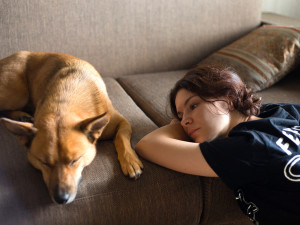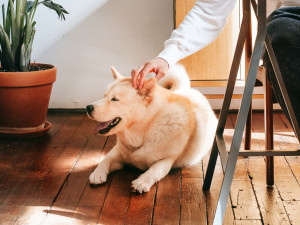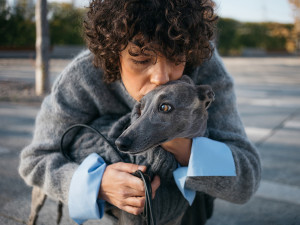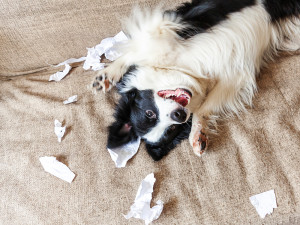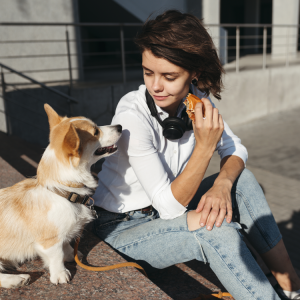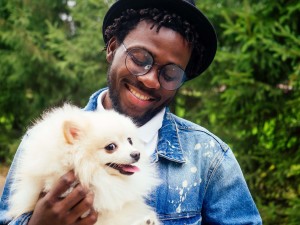How to Improve Your Relationship with Your Dog
Animal behaviorist Dr. Karen B. London on how to strengthen your pet-parent bond.

Share Article
Whether you picked this up from therapy or one of the more realistic rom-coms out there, you likely know this universal truth: Relationships take work. A lot of that work is the same across species; if you pick up a book about improving your relationship with a partner, child, or friend, it’ll likely offer similar advice as books about bonding with your dog.
It makes sense: We all just want to be loved, respected, and gifted the occasional homemade treat or heart-shaped charm. Below are nine ideas that will help you improve your relationship with your dog (no judgment if you try them on your human friends, too).
1. Spend time together.
Good news: Another excuse to spend the day cuddled up with your dog. A relationship is about being with one another and sharing experiences, so spending time together will strengthen your bond — especially if you spend that time in enjoyable ways. Try going out for a sniffari and putting in some quality playtime with your pup.
2. Communicate clearly.
It’s cliché advice for a reason: Communication really is everything. Misunderstandings and confusion are the enemies of good relationships, so be as clear as you can when you communicate with your dog. Be consistent with your training signals. Because dogs tend to learn visual signals faster than vocal cues, use the former when possible. Dogs pay attention to what you do more than to what you say, which means that you should attend to what you do when you communicate with them. You’ll feel closer when there’s greater understanding between the two of you.

3. Put a little love into their food.
The way to dogs’ hearts is through their stomach, and preparing healthy, tasty food for your dog shows you care. You can choose to cook for your dog or simply focus on providing the best nutrition in the most delicious way possible.
4. Train your dog.
Well-trained pups are allowed greater freedom. If they come when called, they get to spend more time off leash. If they don’t go for the food on the table, they can stay nearby during meals. Training also reduces frustration because when you ask your dog to do something they’ve been taught to do, they know exactly what you want — no guessing games or back-and-forth required.
5. Be playful.
There’s a reason I called one of my books Play Together, Stay Togetheropens in new tab. Scientists have observed that, across a variety of species, parents who play with their children have the closest relationships with them, and this also seems true in relationships between people and dogs. Playing games and having fun together strengthens your bond.
6. Remain calm.
Losing your temper, yelling, or freaking out in any way upsets everyone in the vicinity of the emotional storm, even if it doesn’t have anything to do with them. No matter what’s going on, exude a sense of tranquility so your dog can count on you to keep your cool.
7. Learn more about dog behavior.
Especially body language and facial expressions that indicate stress. When you can identify the signs that your dog is anxious or scared, it’s easier for you to protect or remove your dog from situations that make them uncomfortable. If your dog can count on you to keep them safe, the trust between you will be better and, in turn, so will your relationship. There are a number of excellent books and DVDs on this subject; look for works by Patricia McConnell, Suzanne Hetts, Daniel Estep and David Grant, and Barbara Handelman.
8. Pay attention to your dog’s likes and dislikes.
Knowing your dog’s preferences, (such as favorite games and foods), means that you can give them what they really want and be the source of all things wonderful. Similarly, keep track of what your dog can’t stand. A good starting place is to know the things that most dogs find unpleasant: head pats, citrus, or strong floral scents, loud noises, being stared at, being dressed up in clothes that impede their ability to move, and being hugged.
9. Pet your dog.
There is strong evidence that physical contact, such as grooming and petting, lowers stress in shelter dogs, which is measured by reductions in both heart rate and the stress hormone cortisol, as well as by an increase in the anti-stress hormone oxytocin. This has led researchers to believe that physical contact plays a role in enhancing the bond between people and dogs.
Focusing on your relationship is arguably the most important aspect of living with a dog. After all, you love your dog as a friend and family member, and being with them enhances your life in many ways. It’s all about the relationship, which is worth improving no matter how magnificent it is already.

Karen B. London, PhD, CAAB, CPDT-KA
Karen B. London is a certified applied animal behaviorist (CAAB) and certified professional dog trainer (CPDT) who specializes in working with dogs with serious behavioral issues, including aggression. She has written for a variety of magazines including The Bark, Clean Run, and the APDT Chronicle of the Dog, and has published in scientific journals including Behavioral Ecology and Sociobiology, Ethology, Ecology, and Evolution, the Journal of Insect Behavior, and Insectes Sociaux. She is the author of seven books about dog training and canine behavior, including the forthcoming My Dog's Mystery Adventure: And Other Stories From a Canine Behaviorist and Dog Trainer.
Related articles
![Happy pet owners cuddling with their dog]()
How to Spark Joy in Your Dog’s Life
(And your own, while you’re at it.)
![Puppy laying in torn up paper on the couch]()
New Puppy Driving You Nuts? Here’s How to Deal
The beginning of puppy parenthood can be rough, but it does get better — especially when you implement this advice.
![corgi giving woman puppy dog eyes begging for food]()
A New Study Debunks the Theory That “Puppy Dog Eyes” Are for Humans’ Benefit
Apparently wild dogs can be pretty cute, too.
![Man hugging his fluffy white dog happily]()
Chemistry Between People and Dogs Is Real (It’s Science)
How the “love hormone” oxytocin connects us with our pups.
![Young woman sitting at desk petting her senior Great Dane]()
How to Speak “Dog”
Lili Chin’s book Doggie Language illustrates how dogs communicate — beyond ear perks and tail wags.
![illustration of multi-colored dogs]()
Is Your Dog Tricky to Train? Here’s Why You Shouldn’t Feel Guilty
It’s important to remember that dogs are individuals, so training isn’t one-size-fits-all.
